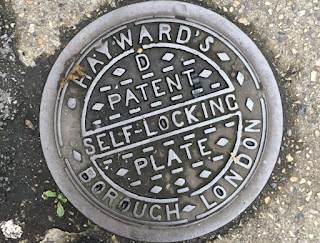I have often pulled together collections of coal hole cover plates showing how diverse the range of designs can be. Most of them sport a pattern on them, often used for advertising, to make them anti-slip. I've also noticed how most show no visible signs of how these covers/lids might be lifted. Evidence about this process, or diagrams to explain the construction, has proved elusive or inconclusive.
 Whilst presenting a talk about coal holes at London Historians History in the Pub evening last month I asked the audience for ideas about their usage and the consensus was that the scullery maid would have pushed up the cover plate from the coal bunker below so that the delivery man could then remove the lid by hand. He would them drop it back into place after delivering the order. Being flush to the pavement, with no protruding lips to get a grip on, meant the lid was unlikely to be tampered with, or stolen/removed, and the coal below was as good as inaccessible via a short narrow access pipe barely big enough to squeeze your head through.
Whilst presenting a talk about coal holes at London Historians History in the Pub evening last month I asked the audience for ideas about their usage and the consensus was that the scullery maid would have pushed up the cover plate from the coal bunker below so that the delivery man could then remove the lid by hand. He would them drop it back into place after delivering the order. Being flush to the pavement, with no protruding lips to get a grip on, meant the lid was unlikely to be tampered with, or stolen/removed, and the coal below was as good as inaccessible via a short narrow access pipe barely big enough to squeeze your head through.
Ah, but then we have the dilemma of the 'self-locking' plates as shown above in the Hayward's example. This rather intimates a mechanism of some kind. Perhaps the maid pressed or released some kind of spring/catch below ground that allowed the plate to pop up proud of the pavement and when the plate was dropped back down into the outer casing the lock was reactivated, making the whole thing more secure
However, look closer at the pic and see that there are little notches each approx half long around each of the parts. On the plate there are four of them at 90 degrees to each other and on the ring there are six at 60 degrees. Perhaps the plate was rotated somehow to either align two pairs of notches to enable opening the unit, and/or dis-aligned to lock it. Oh, I don't know. Also, the plate is heavy, so how could they have rotated it? Perhaps a big magnet was involved?
Whatever the case, quite a few of these self-locking plates must have proved unsuccessful seeing as additional locking mechanisms were later added as per here, though I have noticed many more retro-fitted locks on these things that missive.
Another thought: Hayward's were the B&Q of their day and as such would most certainly have produced an extensive catalog ... do you have any reference of these?
All suggestions welcome. Please use the comments section below or email me at [email protected]
